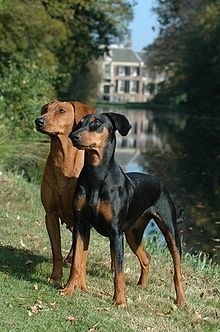SD ~ German Pinscher Mystery Cache
-
Difficulty:
-

-
Terrain:
-

Size:  (micro)
(micro)
Please note Use of geocaching.com services is subject to the terms and conditions
in our disclaimer.
This cache was placed as part of the MAMD Dog Series. The cache is NOT at the posted coords but is hidden in Plaistow.

The German Pinscher (original name Deutscher Pinscher) is a medium-sized breed of dog, a Pinscher type that originated in Germany. The breed is included in the origins of the Dobermann, the Miniature Pinscher, the Affenpinscher, the Standard Schnauzer (and by extension the Miniature Schnauzer and Giant Schnauzer).
The German Pinscher is a moderately small sized dog, usually weighing between 25-35 pounds and typically 17-20 inches in height, with a short coat. Colors for this breed include black and rust, red, fawn, and blue and tan. For all countries where the Fédération Cynologique Internationale standard applies, only black and rust and solid red are allowed colors. Colors that became extinct during the world wars of the twentieth century include solid black, and salt-and-pepper, and harlequin. German Pinschers customarily have their tails docked and ears cropped, as has been done for over 200 years in countries where the procedures are legal. Historically, tail docking was thought to prevent rabies, strengthen the back, increase the animal's speed and prevent injuries when working. For utilitarian reasons, ears also were cropped to prevent injuries while working and increase the intense appearance of the canine and eliminate the subdued, "puppy" look of droopy ears. Today, these are both done mainly for cosmetic reasons.
The Wire Haired and Smooth Haired Pinschers, as the Standard Schnauzer and German Pinscher were originally called, were shown in dog books as early as 1884. However drawings of the German Pinscher date back to at least 1780, and the breed likely traces its roots to varieties of ratters well established on farms in Germany as far back as the 15th century. These medium-sized dogs descended from early European herding and guardian breeds.
The source of the German Pinscher can be traced back to 1836 when this breed surpassed the Mops in popularity. Pinschers were used as guardians for coaches. They also lived in homesteads where they were used to kill vermin, a job they did by instinct, as such behavior did not need to be trained into the breed. Even today you can observe German Pinschers searching for and finding rats in open areas and in homes.
The Standard Schnauzer (then referred to as the Wire Haired Pinscher) was originally born in the same litter as the German Pincher. Over time, breeders decided to separate the "varieties," changing them to actual "breeds". After three generations of the same coat were born, the Pinscher-Schnauzer club allowed them to be registered as their respective "breed".
The German Pinscher came to breeders in the United States in the early 1980s, though accounts of singular German Pinschers appearing in the country before then have been noted. In 1985, the German Pinscher Club of America was started by various German Pinscher fanciers, most of whom are no longer active in the breed. At this time, the German Pinscher was shown in rare breed shows.
From 1950 to 1958 no litter had been registered. Credit is attributed to Werner Jung for collecting several of the breed in 1958 to continue the German Pinscher as we know the breed today. The German Pinscher gained full acceptance by the American Kennel Club in 2003.
The cache is located at: N42 51.635 W71 06.293
Additional Hints
(Decrypt)
Ng onfr bs ynetr ebpx haqre n fznyyre ebpx snpvat ebnq.